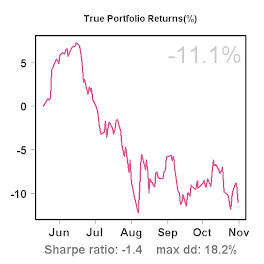Alpha / Beta Plots
For those who prefer a visual representation of the information in my previous post, have a look at the plots below:
The plot in the upper-right corner shows for each day (dot) the system's return (vertical axis) and the index' return (horizontal axis). The red line is the linear (least squares) regression line, with slope equal to beta and intersection with the horizontal axis equal to alpha.
The plot in the lower-left corner shows the same for weekly returns, and the plot in the lower-right corner shows monthly returns. Finally the plot in the upper left corner shows equity curves and indices using daily data (colors correspond to colors used in daily, weekly and monthly plots, e.g. green = Nasdaq Bank etc.)



2 comments:
Unless you KNOW these "systems" do well through "corrections" - save your cash and USE YOUR OWN STOPS or limits to trade losses. Or the 12% DD you are experiencing can get "unrecoverably" worse.
Just a bit of "healthy common sense" from the 'non-sensical one', gA
Thanks for your concern and sharing. It's interesting that you bring this up today, because today is a good example how to mitigate corrections by using put options. While the S&P500 is down 2.3% today, I'm almost flat in my account (you'll notice this in the P/L curve this evening when I update it). The betas I estimate are required to calculate the optimal number of options for the hedge. Any drawdowns you see are unlikely to be related to corrections in the broader market.
I'm not too worried about the drawdown, because both the run-up and the drawdown were mostly caused by extreme-os, which is no longer included in the portfolio. You can see that on C2 extreme-os nicely recovered from the drawdown, but in my account it didn't because of technical problems (missed trades). I don't expect any such problems with the current systems in my portfolio because they don't rely on auto trading and are entirely end-of-day.
Post a Comment